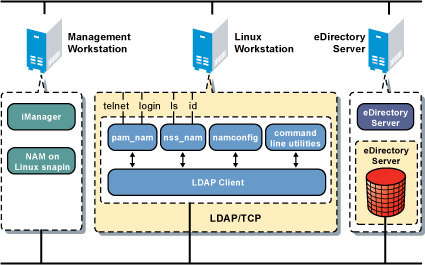5.1 Tips and Technologies
Linux User Management uses the Pluggable Authentication Module (PAM) framework to manage account authentication and other access requests. PAM provides an extensible interface that applications can use to resolve access requests.
After Linux User Management components are installed and configured on a Linux workstation or server, eDirectory is used for requests relating to authentication, account management, password management, and session management. Linux User Management technology leverages the following components to provide login access through eDirectory.
-
pam_nam: Provides authentication, account, session, and password services for all PAM-enabled applications on the server.
-
nss_nam: A Name Service Switch redirector that enables user access to system resources by checking user profiles against access rights.
-
namconfig: A Linux command line utility that lets you set Linux User Management configuration parameters. You can also use namconfig to import the SSL certificate into the local machine.
-
Other command line utilities: Linux User Management provides Linux command line utilities for creating, managing, and deleting user and group accounts.
-
iManager plug-in: Administrators running iManager on a Linux server can use iManager to create, manage, and delete user and group accounts.
The following figure provides a graphical overview of Linux User Management components.
Figure 5-1 Linux User Management Components
